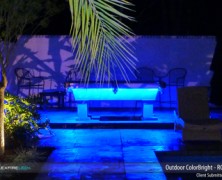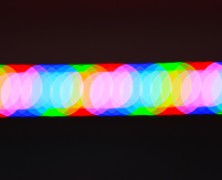When the Seattle Seahawks face off against the New England Partiots at this upcoming Super Bowl, LED stadium lighting will illuminate the field. Scheduled for Feb. 1st, the game will be the first NFL championship match that has ever been lit with LED lights. The LED lights were installed last fall at University of Phoenix Stadium. The Arizona Cardinals and San Francisco 49ers were the first to play a game on Sept. 21st, 2014 under the new lighting system. The LED stadium lighting will significantly increase the light on the field and will produce a more vivid picture on the screen for the 110 million plus expected viewers of this year’s game. The light will shine in a more uniform manner than the legacy system, creating less shadows and a clearer view of the action taking place on the field. Another advantage of LED lighting is the fact that they don’t flicker, which will lead to less distractions during slow-motion replays. There will be 312 LED fixtures installed to replace the 780 metal halide lights. The new LED stadium lighting will use just 380,000 watts compared to the 1.24 million watts needed to power the old system. Combined with savings generated for lower air-conditioning costs, most venues that choose LED stadium lighting enjoy a 75% reduction in overall energy consumption. Further, the system will age more gracefully than metal halide lights, which take on a reddish hue and lose brightness over the years. The University of Phoenix Stadium was originally opened in 2006. With its innovative design that includes a retractable roof and field, it’s recognized as one of the most advanced stadiums in North America in terms of its engineering. This multi-purpose facility previously hosted Super Bowl XLII in 2008. It also hosts the annual Fiesta Bowl, and numerous international soccer matches. The stadium seats 63,400 fans, but is expandable to seat 72,200. Questions? This Super Bowl Sunday will be lit by LEDs? Just another reason that Flexfire LEDs is excited about being a part of the future of LED lighting! If you have any questions about LEDs, and specifically LED strip lighting, remotes, and dimmers, please stop by our website at flexfireleds.com or give us a call at 1-844-FLEXFIRE (1-844-353-9347) to talk with one of our design specialists...
5 Different Ways To Use Color Changing Led Strip Lights...
posted by Taran Volckhausen
Flexfire LEDs ColorBright RGB Color-Changing Strips are popular for both home and commercial applications. In this post, we present you with five ideas for using color changing LED strip lights. Waterside Color Changing LED strip lighting Who doesn’t like spending time by the pool or the lake during warm summer nights? Color changing LED strips are great for this purpose because the changing colors will boost the mood of your gathering, be it among friends or family. Make sure that the lights are rated for outdoor use and that they are water resistant. Flexfire LEDs offers two choices for outdoor-rated color changing LED strips: ColorBright RGB 150 Outdoor strips and ColorBright RGB 300 Outdoor strips. The 300 RGB have double the amount of LED diodes per reel and produce twice as much light as the 150 RGBs. Living Room Color-Changing LED strip lighting Color changing LEDs in the living room are a great way to start a party, or set the mood on a date. Or to help you find your “happy place” after a stressful day at work. Did you know that light color has a significant effect on on our moods? That means putting color changing lights in the living room will give you greater control not only of your lighting environment, but also of your mental state. While many people come to us in their search for colorful lights, they would like a “white light” option as well. For these clients we suggest our ColorBright RGB plus Warm White strips. Using a remote, users switch between warm white setting and the RGB color-changing setting. The result of this amazing pairing is beautiful and allows for an unparalleled degree of personal customization. Stage Color-Changing LED strip lighting Most people write off strip lights for stage lighting purposes because...
Visual Light Communication And Customer Engagement...
posted by Taran Volckhausen
With the rise of the smartphone and ubiquitous internet connectivity, retailers have found themselves on the hunt for new ways to interact with their guests. One of the most promising of these is LED-based Visual light Communication (VLC), which gives retailers a powerful in-store tool to engage with customers. The opportunity to harness the power of VLC (also known as Li-Fi) is another great reason for retailers to make the switch to LEDs. LED technology makes VLC possible because of the extremely fast rate at which the chips can be switched from on to off, and vice versa. This rapid fire switching means LED lighting systems can be modulated with computer chips to convey data at such a fast rate that the human eye won’t even perceive a flicker in the constant white light used to light the store. The LED lights communicate with the camera lens of mobile devices. Shoppers in the store will opt in to “listen” to the VLC-based communications, supplying the store with extremely accurate location data similar to GPS, but it works indoors and its accuracy rate is within centimeters. The store could then use the data to provide location-based services or personalized content to shoppers as they browse the aisles. The technology could also be used to serve as a navigation device in airports and museums. Already the Museum of Science in Boston is featuring the first pilot project by ByteLight, a startup that uses LED lighting equipped with chips and software to provide visitor locations and promote interactive learning. The LED system uses VLC to communicate with iPad cameras to create a richer experience, and to provide a fuller breadth of information for the exhibit which pertains to how digital technology is affecting our lives. While traditional technologies such as signs...
What Is Li Fi Technology? LED Lights Connecting Us To The Internet...
posted by Taran Volckhausen
Li fi technology, also known as light fidelity or Visible Light Communication (VLC), uses flickering LED lights to transfer wireless data. If you’re reading this, chances are you’re familiar with Wi-fi and have probably already used it at some point today. Wi-fi is a technology that allows you to use radio waves to connect to the internet. But what if instead of spewing out Wi-fi radio waves throughout your house and apartment, you used highly directed beams of LED light? A Li-fi connection would allow your laptop, smartphone or tablet to connect to the internet via the same lights used to light your room. The LED networks work by flickering light at a rapid fire rate, invisible to the human eye. To connect to a Li-fi network, devices must be equipped with the capability to recognize the LED light signals and use them to transfer data. The term “Li-fi” was coined by Harald Haas at a 2011 TED talk, during which he explained that by using a flickering LED light outfitted with a microchip, data can be transferred to laptops and mobile devices. The advantages of Li-fi over Wi-fi are numerous; they increase network security, don’t emit radiation and speed up connection rates. A multitude of micro-LED bulbs allows streams of light to be beamed in parallel, with each stream multiplying how much data can be carried over the connection. Each bulb is enabled to handle millions of changes in light intensity per second, acting as an extremely fast on and off switch and allowing a high speed transfer of binary data – a series of ones and zeros. “If you think of a shower head separating water out into parallel streams, that’s how we can make light behave,” Professor Harald Haas told the BBC....








